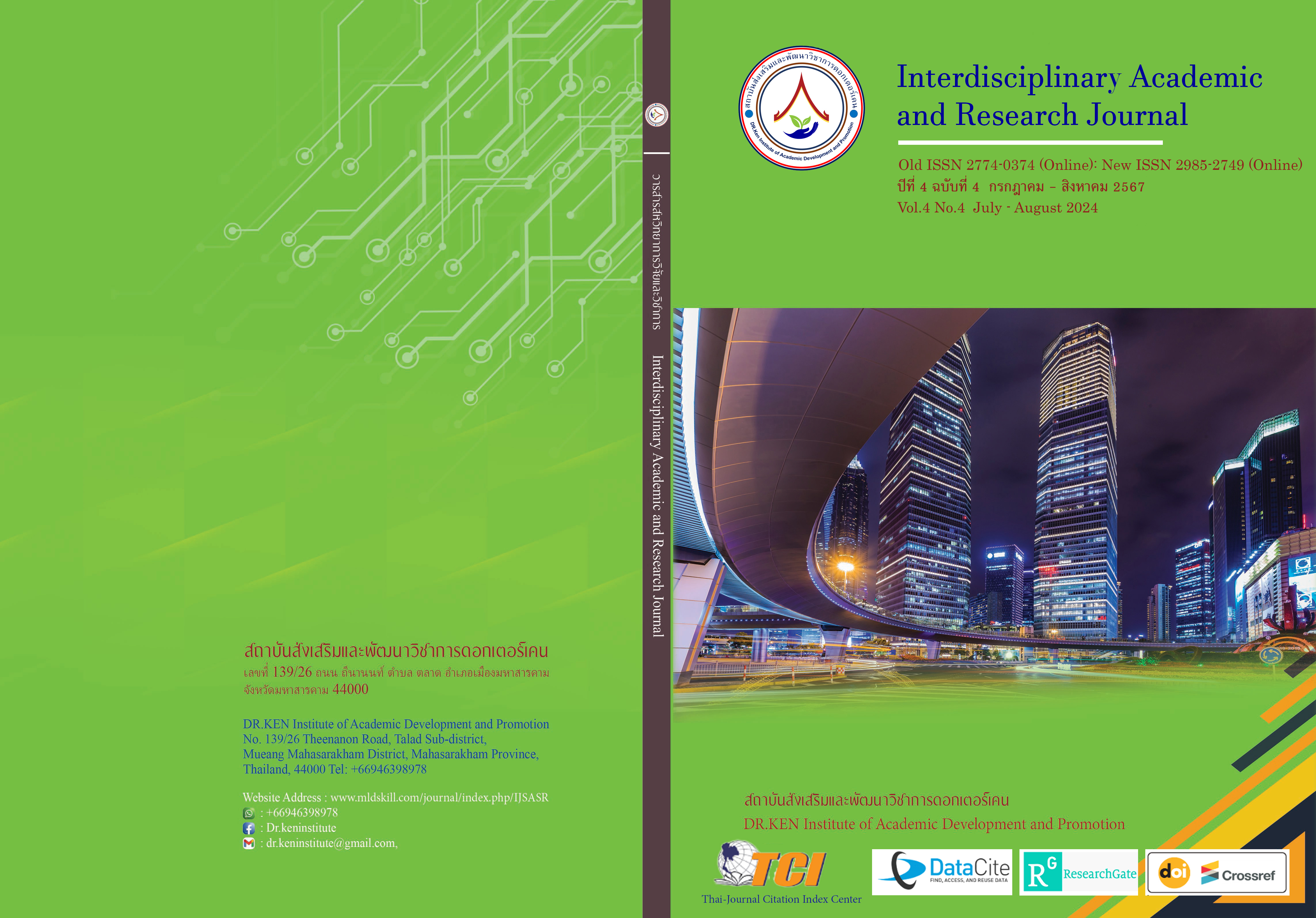Readiness to Implement STEM Education to Foster Learner Development in Accordance with the PISA 2025 Assessment Framework of Teachers Under the Bang Khun Thian District Office, Bangkok Metropolis
DOI:
https://doi.org/10.60027/iarj.2024.276485Keywords:
Readiness; , Stem Education; , PISA 2025 Assessment FrameworkAbstract
Background and Aims: It is an important and attractive process to prepare junior and senior high school teachers to adapt to the PISA 2025 assessment framework, which aims to prepare teachers to teach and support students' learning in the digital world. In this research, the researcher examines (1) the readiness of teachers under the Bang Khun Thian District Office, Bangkok Metropolis to implement STEM education under the PISA 2025 assessment framework; and (2) compares the readiness of the teachers under study with different subjects.
Methodology: The research population consisted of 100 teachers teaching science, mathematics, and computers at the level of higher elementary and lower secondary in schools under the Bang Khun Thian District Office, Bangkok Metropolis. The research instrument was a 25-item checklist. The statistics used in data analysis consisted of descriptive statistics of frequency, percentage, mean, and standard deviation.
Results: The research found are as follows: (1) Overall, the teachers under study exhibited the readiness to implement STEM education under the PISA 2025 assessment framework at a moderate level (the mean score being 76.16 percent of the full score). (2) The readiness of the teachers under investigation with different subjects found the following. The teachers teaching the subject of computers exhibited the mean score of readiness to implement STEM education under the PISA 2025 assessment framework at a higher level than those teaching other subjects. This was considered readiness at a high level (the mean score being 83.56 percent of the full score).
Conclusion: With an average score of 76.16 percent, the study shows that teachers are only moderately prepared to implement STEM education within the PISA 2025 assessment framework. Those who teach computer-related subjects, on the other hand, score 83.56 percent, which is significantly higher and indicates a notable proficiency level that is favorable to successful STEM integration in their teaching practices.
References
กชภัทร สงวนเครือ. (2564). โปรแกรมเสริมสร้างสมรรถนะครูในการจัดการเรียนรู้เชิงรุกตามแนวทางสะเต็มศึกษาสังกัดสำนักงานคณะกรรมการการศึกษาขั้นพื้นฐาน. วารสารสหวิทยาการวิจัยและวิชาการ, 1(1), 1-28.
กระทรวงศึกษาธิการ. (2560). ตัวชี้วัดและสาระการเรียนรู้แกนกลาง กลุ่มสาระการเรียนรู้วิทยาศาสตร์ คณิตศาสตร์ และเทคโนโลยี (ฉบับปรับปรุง พ.ศ. 2560) ตามหลักสูตรแกนกลางการศึกษาขั้นพื้นฐาน พุทธศักราช 2551. กรุงเทพฯ: โรงพิมพ์ชุมนุมสหกรณ์การเกษตรแห่งประเทศไทยจำกัด.
จินตนา เบ้าสุภี. (2566). การจัดการเรียนรู้แบบสะเต็มศึกษาเพื่อส่งเสริมความคิดสร้างสรรค์ และเจตคติต่อวิทยาศาสตร์ของนักเรียนชั้นมัธยมศึกษาปีที่ 1.วารสารสหวิทยาการวิจัยและวิชาการ, 3(5), 569-588.
บุสดี ดุสิตา. (2566). การจัดการเรียนรู้แบบบูรณาการตามแนวคิดสะเต็มศึกษาร่วมกับห้องเรียนกลับด้านเพื่อพัฒนาผลสัมฤทธิ์ทางการเรียนและทักษะความคิดสร้างสรรค์รายวิชาเคมีของนักเรียนชั้นมัธยมศึกษาปีที่ 5โรงเรียนปะคําพิทยาคม. วารสารสหวิทยาการวิจัยและวิชาการ, 3(5), 671-686.
วิจิตตรา ภาวะโคตร. (2561). การศึกษาความพร้อมในการจัดการเรียนรู้แบบสะเต็มศึกษา ของเขตพื้นที่การศึกษามัธยมศึกษาเขต27 จังหวัดร้อยเอ็ด. วิทยานิพนธ์ปริญญามหาบัณฑิต, มหาวิทยาลัยราชภัฏมหาสารคาม.
ศิริพร ชวนชัยสิทธิ์. (2561). การศึกษาความพร้อมในการจัดการเรียนรู้แบบสะเต็มศึกษาของเขตพื้นที่การศึกษามัธยมศึกษาเขต24 จังหวัดกาฬสินธุ์. วิทยานิพนธ์ปริญญามหาบัณฑิต, มหาวิทยาลัยราชภัฏมหาสารคาม.
สถาบันส่งเสริมการสอนวิทยาศาสตร์และเทคโนโลยี. (2560). คู่มือจัดกิจกรรมสะเต็มศึกษา. กรุงเทพฯ: โรงพิมพ์คุรุสภา ลาดพร้าว.
สถาบันส่งเสริมการสอนวิทยาศาสตร์และเทคโนโลยี. (2561). ตัวชี้วัดและสาระการเรียนรู้แกนกลาง กลุ่มสาระการเรียนรู้วิทยาศาสตร์ (ฉบับปรับปรุง พ.ศ. 2560) ตามหลักสูตรแกนกลางการศึกษาขั้นพื้นฐานพุทธศักราช 2551. กรุงเทพฯ: โรงพิมพ์ชุมนุมสหกรณ์การเกษตรแห่งประเทศไทย จำกัด.
สถาบันส่งเสริมการสอนวิทยาศาสตร์และเทคโนโลยี. (2562). ผลการประเมิน PISA 2015 วิทยาศาสตร์ การอ่าน และคณิตศาสตร์ความเป็นเลิศและความเท่าเทียมทางการศึกษา. กรุงเทพฯ: โรงพิมพ์คุรุสภา ลาดพร้าว.
สถาบันส่งเสริมการสอนวิทยาศาสตร์และเทคโนโลยี. (2566). ผลการประเมิน PISA 2015 วิทยาศาสตร์ การอ่าน และคณิตศาสตร์ ความเป็นเลิศและความเท่าเทียมทางการศึกษา. กรุงเทพฯ: โรงพิมพ์คุรุสภา ลาดพร้าว.
สำนักการศึกษา กรุงเทพมหานคร. (2563). แผนพัฒนาการศึกษาขั้นพื้นฐานกรุงเทพมหานคร ฉบับที่ 3 (พ.ศ. 2564 – 2569) . กรุงเทพมหานคร : สำนักการศึกษา กรุงเทพมหานคร.
สุทัศน์ บุญสิทธิ์. (2560). การพัฒนายุทธศาสตร์การจัดการเรียนรู้ตามแนวคิดการเรียนรู้โดยใช้ปัญหาเป็นฐานและเมตาคอกนิชัน เพื่อส่งเสริมความสามารถในการคิดเชิงวิทยาศาสตร์ และการคิดไตร่ตรอง ของนักเรียนระดับประถมศึกษา. วารสารศึกษาศาสตร์มหาวิทยาลัยนเรศวร, 19(4), 253-264.
Koehler, C. (2013). The Nexus between Science Literacy and technical literacy; a state-by-state analysis of Engineering Content in State Science Standards. Journal of STEM Education, 14(3), 5-12.
Ramli, A.A., Ibrahim, N.H., Surif, J., Bunyamin, M.A.H., Jamaluddin, R., & Abdullah, N. (2017). Teachers’ readiness in teaching stem education. Man in India, 97(13), 343-350.
Downloads
Published
How to Cite
Issue
Section
License
Copyright (c) 2024 Interdisciplinary Academic and Research Journal

This work is licensed under a Creative Commons Attribution-NonCommercial-NoDerivatives 4.0 International License.
Copyright on any article in the Interdisciplinary Academic and Research Journal is retained by the author(s) under the under the Creative Commons Attribution-NonCommercial-NoDerivatives 4.0 International License. Permission to use text, content, images, etc. of publication. Any user to read, download, copy, distribute, print, search, or link to the full texts of articles, crawl them for indexing, pass them as data to software, or use them for any other lawful purpose. But do not use it for commercial use or with the intent to benefit any business.
















.png)


